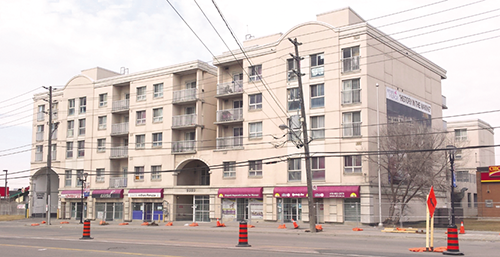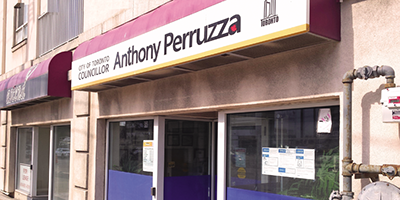Bringing it together at Amansie Place
By Tim Lambrinos
Travelling near the centre of Emery Village, residents will see City councillor Anthony Perruzza has a new curbside presence. His constituency office is now located along the front walkway of Amansie Place, a large apartment building on the north side of Finch, just west of Weston Road. While quite nondescript, it is a property with a story to tell.
The site was home to the Gray Family farmhouse. John and Margaret Gray were rural residents of Emery Village from the 1930s, and it is here that they raised two children, Susan and Danny. In 1957, they befriended the Nordensen family, who had immigrated from Oslo, Norway. Berit Nordensen passed away in June of 2020, having reached her milestone 100th birthday. A real accomplishment for Emery’s first documented Norwegian connection that included husband Ivor, and children Kjell and Vera Nordensen.
 Eventually, the Gray farmstead was sold and gave way to a fire station that would serve the community from 1964 until its relocation to 75 Toryork Drive in 1997. Prior to 1964, local fire service came to Emery’s rural and suburban communities from the Humber Summit Volunteer Fire Brigade at Islington and Whitfield Avenue.
Eventually, the Gray farmstead was sold and gave way to a fire station that would serve the community from 1964 until its relocation to 75 Toryork Drive in 1997. Prior to 1964, local fire service came to Emery’s rural and suburban communities from the Humber Summit Volunteer Fire Brigade at Islington and Whitfield Avenue.
With the move to Toryork Drive, the vacant fire station would sit empty for many years until being repurposed. And this is where the property’s simple past takes a complicated turn.
Its new incarnation was born in 2001 when the City of Toronto’s Administration Committee envisioned a modern-looking housing facility in Emery Village for new Canadians coming from Ghana, Africa.
The project was funded by the city’s Let’s Build Program in an effort to add affordable housing to the community. There was a city-run incentive program that promoted private/public partnerships by creating various affordable development options. Some formal incentives offered by the Affordable Housing Department included financial aid, free land grants and the waiving of fees and levies.
With guidelines created by Toronto’s Housing First Policy, a not-for-profit group was formed to develop a site close to the centre of Emery Village. An initial $576,000 grant was approved by Toronto City Council. A public consultation meeting was held on May 29, 2001 at Habitant Arena on Weston Road and general approval was given by the community.
By 2003, with no real progress on the building or the selection of a site, the city found an ideal site through the Emery Village Secondary Plan - the city-owned surplus land at 2350 Finch Avenue West. A new, affordable apartment building was deemed a logical replacement.
The group identified to sponsor the build was the Ghana Amansie Multicultural Association, whose objective was to assist new immigrant families with entering Canadian society.
The next year, a non-profit corporation called the Ghana Amansie Canadian Non-Profit Homes Incorporated was established, with Larry Agyeman named the group’s first vice-president.
From the outset, the project was troubled. Hold-ups during the planning application phase increased capital spending. And changes in government policies put a major squeeze on the group’s finances as anticipated capital funding from previous federal and provincial housing programs had dried up.
To make matters worse, city staff determined that the design of the building needed substantial changes in order to meet essential parking and waste requirements. Once again, these unforeseen changes to the plans resulted in large increases in capital spending.
In April 2007, a city survey showed that Ghana Amansie had insufficient funds to complete the project. They reported financial difficulties arose when cost increases were incurred for additional mechanical and electrical systems.
City staff wrote that the development team tendered the project without having completed a design for the electrical and mechanical system. The construction contractor’s budget had been accepted by the group, but it was based on an estimated cash allowance for the components before an actual design was completed.
The group’s forecasted allowance seriously underestimated the mechanical and electrical components that were now required for the project. As well, the costs of carrying construction financing for longer periods than expected and the costs associated with contractor demobilizing and remobilizing bloated the budget even further, causing more problems.
In July of 2005, Toronto City Council approved further funding for the project that included a recommendation for $1,392,000 under the pilot project component of the new federal/provincial Affordable Housing Program. It was also supplemented by a CRF loan in the amount of $1,584,000.
However once again, there became another funding shortfall needed to complete the remainder of the build. The first lender refused to advance more funds until the group could assure that full financing would be available to complete the entire project. Consequently, the construction contractor actually stopped working.
There is no question that the energy, vision and drive of the group was there from day one. But city staff reported that there was an apparent lack of developer expertise and an inability to meet required standards. In the end, city staff stated in a report they had no choice but to intervene and manage the development of the building, including taking any actions they considered necessary to ensure the most efficient and cost effective completion of the project. A final staff report assured that an effective management plan would be put in place.
In 2009, the Emery Village BIA brought some much needed public art to the stark, east facade of the building by commissioning a mural.
As part of their History in the Making series, the mural displays the history of the first two fire stations that served both Emery and Humber Summit. The mural was painted by Etobicoke School of Arts students Filip Matovina and Daniel Patterson. The BIA’s historical marker on the colourful front sidewalk will also highlight the rich history of the location.
Toronto Community Housing Corporation (TCHC) currently runs full operations at the facility with admission priority given to elderly residents who are terminally ill. The current residents of Amansie Place do notice a great number of seniors residing in the building.
Elizabeth Agyemang and her husband Joseph Obeng are two of only around 10 of the original Amansie group remaining. They reside in a unit and are generally pleased with operations, except for when the elevator is out of service. Elizabeth feels that the TCHC is slow to initiate required repairs to the elevator and it has been a recurring inconvenience. She also complains of late-night noise from the townhomes located at the rear of the facility.
Overall, Agyemang likes its central location and looks forward to the new Finch LRT’s completion, but feels that a bus shelter is needed at the Weston Road stop. The prospects of a new shopping centre, that may materialize once the LRT is running, would suit her just fine.
The building’s security department would not address the noise concerns.
“We don’t respond to news reports,” they said.
 City Councillor Anthony Perruzza is just a quick elevator ride and steps away. However, with COVID restrictions, walk-in inquiries cannot currently be received at his Amansie Place office. Individual appointments can be booked by calling (416) 338-5335 or by emailing:
City Councillor Anthony Perruzza is just a quick elevator ride and steps away. However, with COVID restrictions, walk-in inquiries cannot currently be received at his Amansie Place office. Individual appointments can be booked by calling (416) 338-5335 or by emailing:
councillor_perruzza@toronto.ca
Councillor Perruzza invites everyone to follow him on Facebook - @AnthonyPerruzza, Twitter - @PerruzzaTO, Instagram - @Perruzza_TO, and to subscribe to his regular online e-newsletter updates or by visiting his website.
Amansie Place now has a range of accommodation as a central component of TCHC’s mandate with residents originating not only from Africa, but from all over the world. Amansie Place has become a multicultural endeavour that continues to be a notable and worldly part of Emery Village. And even with a sorted history of complications and shortfalls, the facility has proven to harmonize the general community at-large.














